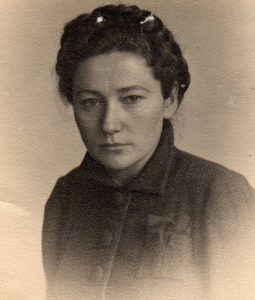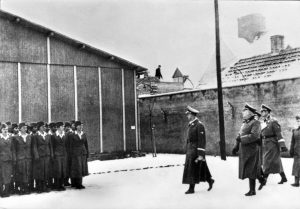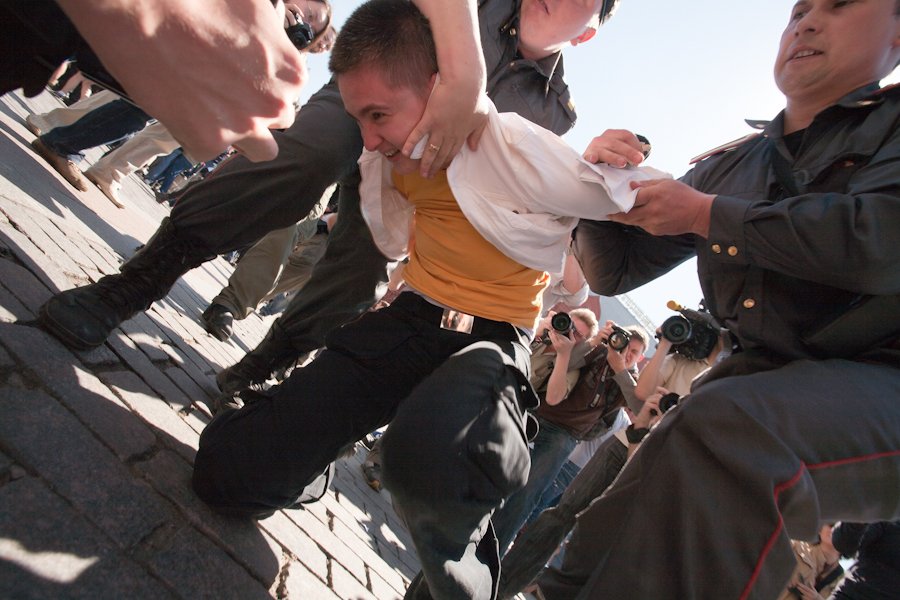
Third in a series of five memoirs written by our mother, Olha Froliak Eliashevska, Nazi death camp survivor.
Our mother was born in a family of eight children in the village of Karliw (present-day Prutivka), Sniatynsky Raion, Ivano-Frankivsk Oblast on December 26, 1919.
As a young Ukrainian student and political activist, she was arrested on December 11, 1943, imprisoned in Wels/Donau and Linz Gestapo prisons,
and then incarcerated in Ravensbrück concentration camp (acknowledged period of detention - from December 11, 1943 to April 5
, 1945).
This is the continuation of her story…
From August 1, 1942 to August 16, 1943, seventy-four Polish female prisoners and an unspecified number of women prisoners of other nationalities underwent horrific surgeries without the use of anaesthesia. They were called “Die Kaninchen”(The Rabbits), women prisoners who were used as human guinea pigs for brutal experimental surgeries, performed on the bones, muscles and nerves of the lower limbs, mostly on the shanks, and sometimes on the thighs.
The surgeries were performed by physicians from Hohenlychen Hospital supervised by Professor Karl Franz Gebhardt and Dr Fritz Ernst Fischer and later by others. The camp’s SS doctors, Dr Herta Oberheuser, Dr Rolf Rosenthal, and Dr Gerhard Schiedlausky participated in these gruesome medical experiments.
In July and August 1944, barrack no.12 was filled with women prisoners from Ukraine - hundreds of exhausted women and young girls, whose days were numbered.
Physical exhaustion did not allow the women to maintain moral stability and sound judgment. Suffering from both extreme hunger and hard labour, the inmates were often driven to madness. Everyone was waiting for the end to come - either death or some form of revenge!
In August 1944, with a fever of almost 40C, I was admitted to barrack no.10, the infamous Revier, the so-called camp “hospital”. I was given a Bettkarte, a card allowing temporary exemption from work and the chance to lie in a proper bed in the camp infirmary. The wound on my throbbing head was dressed with a crepe paper bandage; I was also given some aspirin.
Two other women lay beside me, on the same mattress.
The first one, Valentyna Veres, lay completely naked on the straw mattress that reeked of mouldy dampness. Her glassy eyes stared into the distance; her yellow lips murmured some incomprehensible sounds.
The second woman, Katia Valko, lay motionless, with a piece of bed linen covering her head, sometimes laughing, sometimes wailing loudly.
The woman lying in the bed next to me turned and told me that my two bed mates were Ukrainian prisoners from barrack no.12. Everyone in the infirmary believed that the two had lost their mind…
I looked at their thin, emaciated faces and their feverish eyes; I shuddered, but lifted my head slowly and uttered a few words…
As soon as they heard my voice, their mouths twisted into a grimace… or maybe it was a happy smile? Then, they stretched out their gaunt arms...
Our food rations arrived – a thin gruel of potato leftovers, kohlrabi and a piece of bread. But, we were too weak to raise ourselves and indulge in these “fine treats”. Weakened by illness, we lay motionless, as if frozen in our thoughts.

Suddenly, Katia tore away the dirty bandage from her face, and leaning over on her elbow, raised her head.
I stared at her in horror… One eye was a black, gaping hole, the other a brownish, rotting orbit that glanced around furtively. Katia looked at me, her good eye moist and pleading.
“I know… I look hideous, but I’m still alive!”
Why do they - those sadistic brutes - rob us of the very last human elements that we have and need for our bitter existence? So many thoughts run through my head as I try to focus on my sick friends. Then, I close my eyes and shake my head as if trying to escape from the other thoughts that assail me.
But, Katia’s gaze pierces my heart and soul… She is indeed the embodiment of human folly!
* * *
Night is falling… the infirmary hums with noise and painful cries. All the beds are occupied by ageless human skeletons. Some inmates lift their heads, fragile skulls with abnormally sunken eyes. Yellowish, sagging skin, often covered with abscesses. Others cry out and talk loudly of their hunger, of death… trying vainly to liberate themselves from this nightmare; yet others lie silent, trapped within themselves.
These women, beaten by rubber truncheons and assaulted by fierce dogs, were forced to work twelve hours a day. These women now stand shaking and naked, waiting for the “doctor” to attend to their medical needs. They stand silently in one straight row, and if anyone moves even slightly or falls out of line, she is beaten mercilessly. Many of them are forced to lie on the bare floor, as the beds with straw mattresses are already occupied.
One straw mattress… for three sick women! The living often find themselves lying beside a dead sister, but they are too weak to get up and inform the “nurses”. The stronger ones push the dead body away, thus claiming more space on the mattress. The body lands on the floor with a loud thud, catching the “nurse’s” attention. The nurse curses angrily, and sets upon the “perpetrator”, beating her mercilessly across the face. For this “misdemeanor”, the woman is deprived of food and water for the entire day.
The doors to the so-called Waschraum
(lavatory + washing area) stood near our wall. All the bodies were thrown inside, but among them, there were some that were still alive and breathing. However, they lay there, almost lifeless and indifferent to everything and everyone. Their pain and suffering were about to end. By the early morning, the Waschraum was crowded with dead and half-dead women, one body lying on top of the other. During the night, the rats had eaten off one side of their faces… through the half-open door we could see the naked bodies lying in the middle of debris, their arms hanging listlessly in despair.
I lift my head and glance through the door… the sweat streams from my forehead… perhaps the fever is finally subsiding. My parched lips long for a drop of water…
In the morning, the bodies are removed and taken to the crematorium… but, maybe, in this heap of naked bodies, someone’s heart is still beating?!
* * *
Suddenly, a group of frightened “nurses” rushes into the room:
“Hurry, hurry, the doctors are on their way to inspect the infirmary!”
My two bed mates, Valentyna and Katia rise up slowly and look at me:
“This is the end!” they whisper through trembling lips.
We lower our heads; tears roll down our cheeks… silently dropping on the worn, stinking mattress…

Oberschwester (Head Nurse) Elisabeth Marschall strides into the room with a cohort of kapos and nurses. Naked, we struggle to stand upright so as not to raise suspicion and be labeled as “nicht mehr brauchbar” (no longer useful). I’m told that I can go back to work the next day. Three days of “treatment” are enough; you can now go back to barrack no.16! My face is hot and flushed, but I struggle not to show fear or protest.
Seeing the deathly pallor of my two bed mates and the threatening look on the Oberschwester’s face, we all know what awaits them. We realize that the desire to live has bowed to the inevitable force of death.
The kapos seize Valentyna and Katia and throw them into the so-called “idioten Stube” (mad chamber), a tiny room for “psychotics and the mentally ill”. No one has ever returned from there alive. The windows and doors are always shut, but we hear voices screaming, shouting, singing, laughing, crying… Everyone in the chamber is forced to stand; whoever falls to the ground stays there… and dies there, their bodies trampled by the women still standing. The thin line between death and life is completely blurred. Powerless rage takes over… often bordering on madness.
The women were dying, every hour, every day, every week… and in their stead came new slaves from the “liberated” lands of the so-called new Europe built by the Gestapo.
But, suffering and death did not frighten millions of Ukrainian brothers and sisters who continued their fight for freedom and justice. They will forever be remembered by future generations as the embodiment of true heroism.

Elisabeth Marschall was born on May 24, 1886 and became a nurse in 1909. She rose to the rank of Oberschwester (Head Nurse) in the Revier (hospital) barracks at Ravensbrück, where she brutalized sick prisoners and took part in horrific experiments. She also played an active role in the selection process for the gas chamber; it is estimated that she handpicked over 800 women to be transported to Auschwitz and ultimately to their death.
Between December 5, 1946 and February 3, 1947, sixteen members of the camp staff were arrested and tried on charges of murder and brutality by a military court of British officers and lawyers in Hamburg, the British Zone. All were found guilty on February 3, 1947. Eleven were sentenced to hang, including five women - head nurse Elisabeth Marschall, Aufseherin (overseer) Greta Bösel, Oberaufseherin (senior overseer) Dorothea Binz and kapos Carmen Mory and Vera Salvequart.
41-year-old Carmen Mory cut her wrists during the night of April 9 with a razor blade that she had concealed in her shoe and thus escaped the noose. 27-year-old Dorothea Binz was hanged on May 2, 1947; 60-year-old Elisabeth Marschall and 39-year-old Greta Bösel were hanged on May 3, 1947. Vera Salvequart was executed on June 2, 1947. The executions were carried out in Hamelin Prison, Hamelin, a city in the German state of Lower Saxony.


Olha Froliak-Eliashevska
Prisoner No.49061
Ravensbruck concentration camp for women










